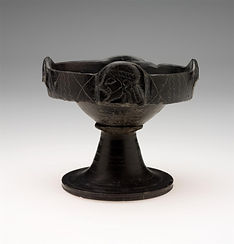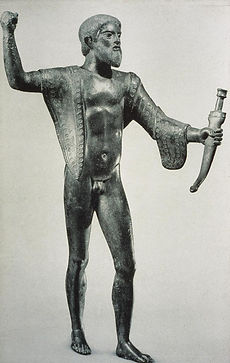Interactions with Classical States
The Etruscans interacted socially and politically with the Classical states from the ninth century to the third century BCE. Trade was an invaluable tool for this interaction. International trade began in the ninth century when the Greeks from Euboea found Etruria and made contact. Etruscans began exploiting their land for natural resources to trade with their newfound Greek acquaintances.
The land of Etruria was rich in metals, especially the hills to the North of Populonia and Vetulonia named Colline Metallifere. Members of the aristocracy in Etruria began trading these metals for finished metalwork and Greek pottery. Greek artisans began migrating to Etruria, bringing their knowledge and ideas with them, which promoted trade and boosted the quantity, quality, and variety of products from Etruria. New farming techniques were also brought by the Greeks. The Etruscans learned about crop rotation and letting fields lie fallow. Subsequently, they began trading wine, olive oil, wheat, and other crops with the Greeks and surrounding civilizations. Wine was often traded in bucchero pottery, which was an Etruscan invention. This bucchero pottery was lustrous and black in color. Much of the Etruscan pottery still available today was found in Etruscan tombs.
Through trade with the Euboeans, the Etruscans had access to the Greek alphabet, which the Etruscans took and adapted to create their own alphabet. Etruscan writing dates back to 700, the oldest example being Etruscan script on pottery. The Romans borrowed the Etruscan writing system and modified it to form their own alphabet several centuries later. Roman numerals were an Etruscan invention.
From Etruscan tombs, we know Etruria adopted several cultural ideas from the Greeks and Romans, like symposia and Greek games. The Etruscans even adopted parts of the Greek and Roman religions. In Gravisca, a Greek sanctuary to the gods Hera, Demeter, and Apollo was found. The Etruscans created their own versions of Greek and Roman gods. Three gods they held most sacred were Tinia, Uni, and Menerva. These gods were the Etruscan versions of the Roman gods Jupiter, Juno, and Minerva. These gods were combined with local traditions to create the Etruscan religion.
Greek trade with the southern portion of Etruria decreased drastically throughout the seventh and eighth centuries, though Northern Etruria increased trade with the Romans by exploiting their land. In 550, many Greeks escaped to Etruria in response to the Persian expansion. A few years later, Greek rulers in Sicily began threatening the Etruscans. In response, the Etruscans launched a military attack that ultimately failed. Beginning in the late sixth century, the Greeks and Etruscans began having conflicts over the Greek city Cumae. Cumae was the northernmost Greek presence in Italy. In 524, the Cumaens successfully fought off an Etruscan attack. In 504, Aristodemus, a Cumaen aristocrat, led 2,000 Cumaens to battle against the Etruscans at Aricia and defeated them. Aristodemus returned to Cumae and made himself dictator. He died approximately 20 years later, after which the Etruscans attacked Cumae. In 474, Cumae allied itself with Hieron I of Syracuse, and the Etruscans were ultimately defeated. Other surrounding civilizations waged war against the Etruscans, ultimately ending most Greek settlements in the Southwest part of Italy.
In 283, the Romans conquered a Gallic tribe. Scared that they would also be conquered, the Boii appealed to the Etruscans, who also disliked the growing power of the Romans. Despite the successful establishment of an alliance, the Romans defeated the Boii and Etruscans by 280, though the Etruscans still refused to submit to Roman rule. At the same time, Etruria had its own domestic concerns. There was dissension among the people and the ruling aristocrats. The Romans, who preferred the aristocracy, used this opportunity to aid the aristocrats in gaining control of the Etruscan people once again. The Romans used this moment of weakness to take Etruscan territory, much to the displeasure of the Etruscans. Shortly after, a new Roman colony was formed at Cosa. The Etruscans rebelled in 265 against the Roman control. The Romans took Etruria completely under their control. The Etruscan culture was not immediately destroyed under the Romans, but it slowly slipped away until the beginning of the Common Era.

Bucchero pottery

A portrait of Tinia (Jupiter)